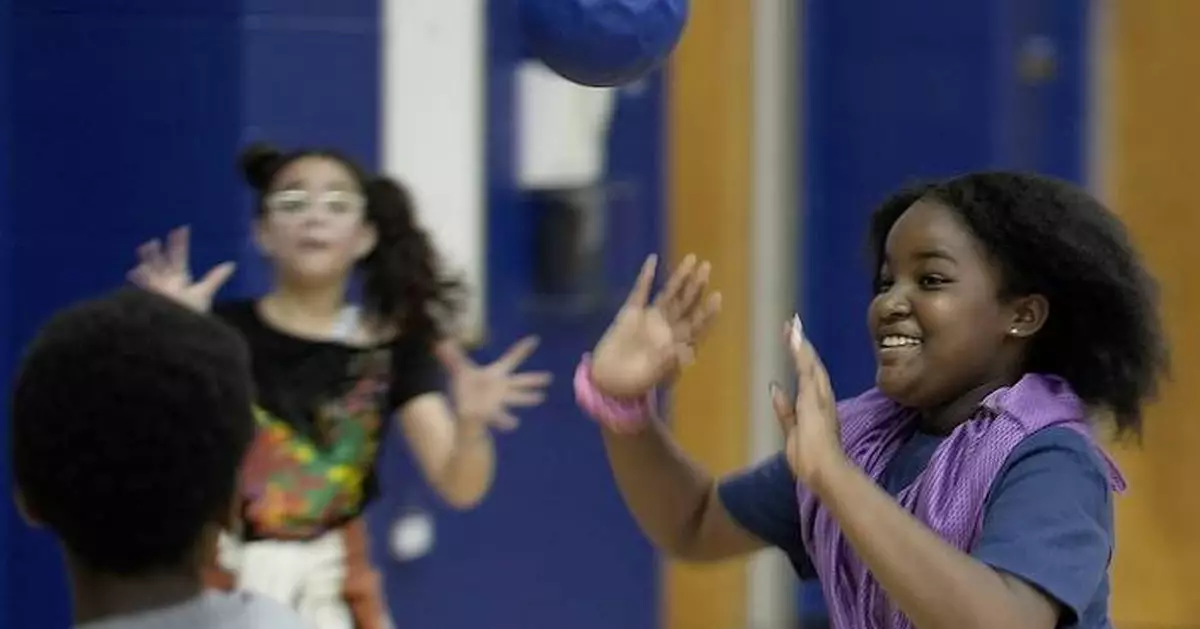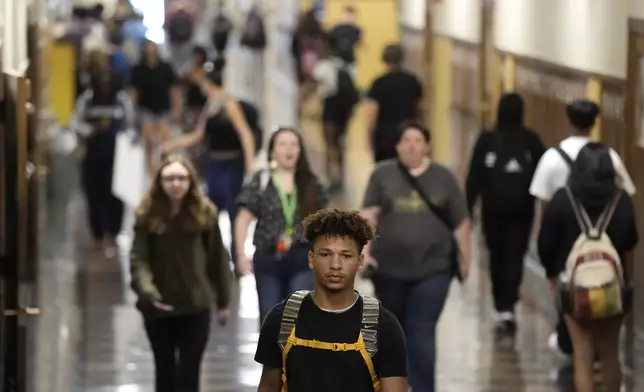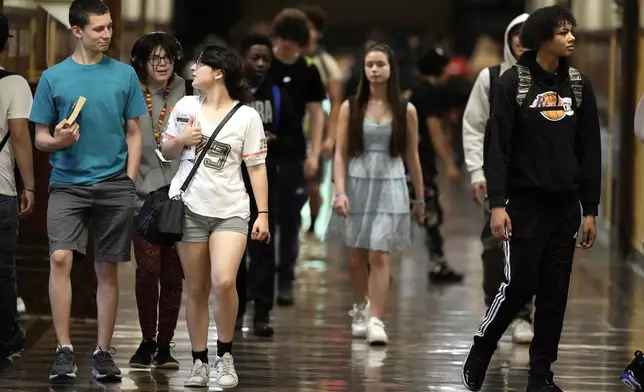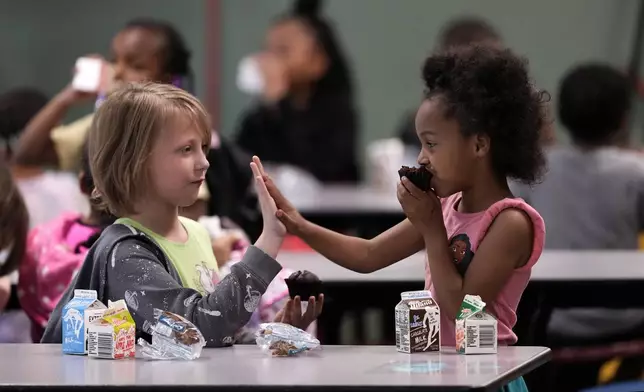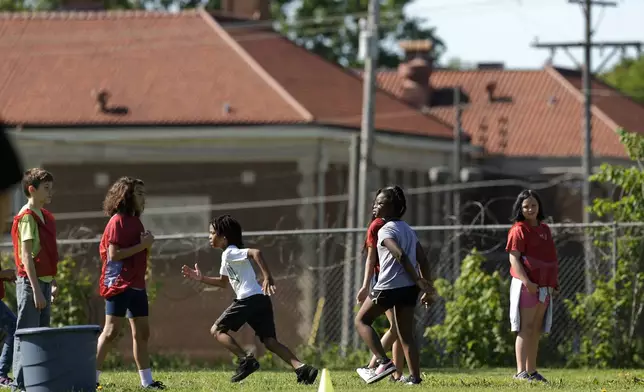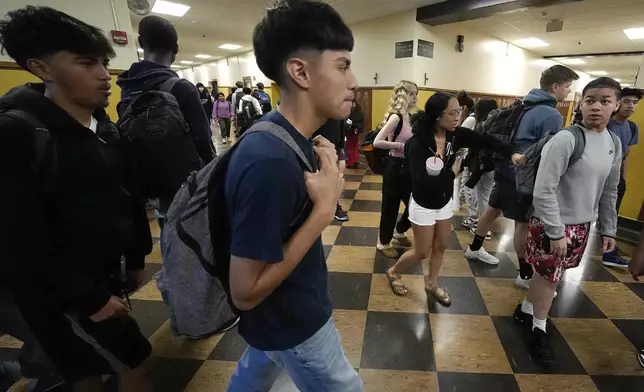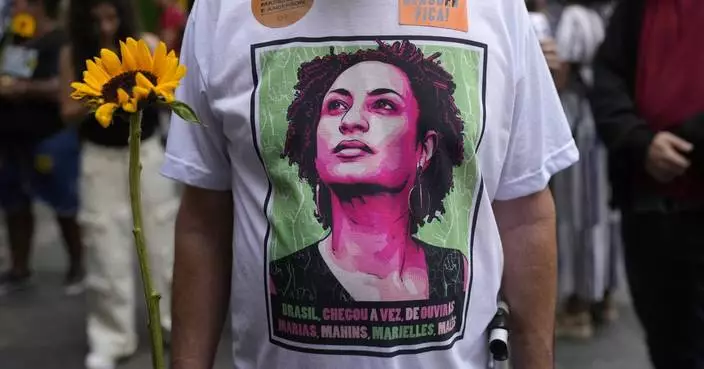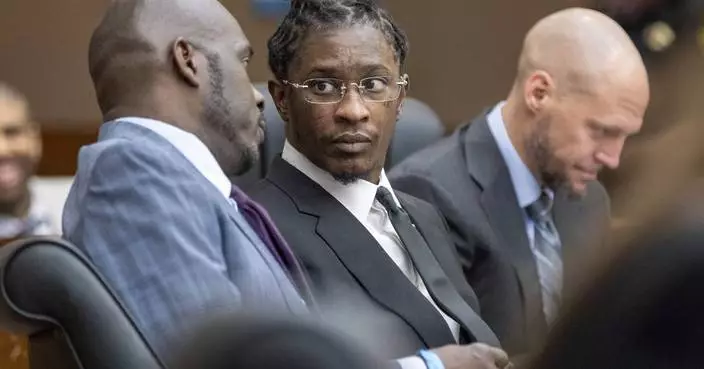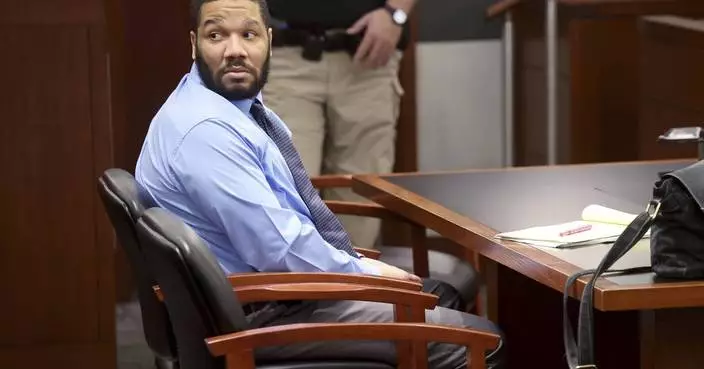TOPEKA, Kan. (AP) — The lesson on diversity started slowly in a first-grade classroom in Topeka, where schools were at the center of the case that struck down segregated education.
“I like broccoli. Do you like broccoli?” Marie Carter, a Black school library worker, asked broccoli-hating librarian Amy Gugelman, who is white.
The students in the sunny, book-filled room were comparing what makes them the same and what makes them different. It’s part of their introduction to Brown v. Board of Education, a ruling commemorated at a national historic site in a former all-Black school just down the street. Linda Brown, whose father Oliver Brown was the lead plaintiff in the case, was a student there after she was denied entry to an all-white school near her home.
Within a few questions, the first-graders at Williams Science & Fine Arts Magnet school watched the two women hold their arms next to each other. “My skin is brown,” Carter observed, “and Mrs. Gugelman’s skin is not.”
And then Gugelman reached the heart of the lesson. “Can we still be friends?”
The students, themselves a range of ethnicities, screamed out “yes!” oblivious to the messiness of the question, to the history of this place, to the struggles with race and equity that continue even now.
Seventy years after the landmark Supreme Court ruling, segregation persists, not as a matter of law but as a reflection of underlying disparities, including in housing. In greater Topeka, as in school systems across America, students of color are concentrated in districts that disproportionately serve low-income families. That racial isolation has lasting consequences as students who attend high-poverty schools have lower graduation rates and less earning potential.
In school lessons, memorials and ceremonies, Topeka is marking its ties to the 1954 ruling that struck down “separate but equal.” But just as clear to many is the legacy of discrimination that stands in the way of its promise of equity.
MaKenzie Johnstone, who is white, enrolled two years ago at Williams, one of the magnet schools built to attract white students to historically Black neighborhoods. At her old district, Auburn-Washburn, which is 72% white, the 11-year-old said she rarely came across people of color.
Now her best friend, 10-year-old Malaya Webster, is Black. The fifth-graders spend recess together, chattering incessantly. Sometimes the subject strays to what happened down the street.
“White people,” Malaya, explained, “couldn’t be next to Black people, which is pretty bad, because we all should be treated the same.”
MaKenzie was outraged, saying, “It made no sense at all.” She described the desegregation case as a piece of distant history — something that happened “back in time.”
To Tiffany Anderson, Topeka’s first Black female superintendent, that's not the case.
“Being here in this magnet school environment, you get to see an array of diversity. But if you drive 20 minutes down the road,” she said, “you might not see any diversity in the student population or the staff population.”
In Topeka, as in much of the rest of the country, court-ordered desegregations have ended but racial imbalances persist. Today, 36% of the Topeka district’s students are white, down from 72% in 1987. The changes coincide with the nation growing more diverse. Yet none of Topeka's neighboring districts have a white enrollment below 64%; one district has a 94% white enrollment.
The concentration of students of color in districts with higher numbers of poor students partially reflects historic redlining and that poorer families couldn't afford to move to suburban districts with more costly homes, said Frank Henderson, who has served on the state and national school board associations.
Four years ago, the largely white suburban district of Seaman, north of Topeka, where Henderson was the first Black school board member, was forced to confront the darker aspects of its past.
In 2020, student journalists confirmed the district’s namesake, Fred Seaman, was a regional leader of the Ku Klux Klan a century ago. After student protests, meetings and surveys, the school board voted unanimously to renounce Seaman and his KKK activities but to keep the name.
The vote followed an election in which two pro-name preservation candidates defeated incumbents. Nationally, critical race theory was in the news.
“I felt it was probably the best that could be done to be able to address this hot issue,” said Henderson, whose 16 1/2-year school board term ended in January.
Madeline Gearhart, who was co-editor-in-chief of the high school newspaper, was disappointed. But now she thinks the student journalists who broke the story laid the groundwork for the issue to be taken up later in a district that is 80% white.
“I just think it’s so ironic that in a world where Topeka was a part of Brown v. Board, we still are maintaining the namesake of the district and not trying to disassociate,” said Gearhart, who is white and now a junior at the University of Kansas.
“I would say,” she added, “it speaks to the larger effects of how Topeka is divided up."
Seven years after the historic ruling, Beryl New began attending the all-Black school, Monroe Elementary, where Linda Brown and another plaintiff child were students. It was still largely segregated, not by district policy, but by redlining.
Her family was friends with the president of the Topeka chapter of the NAACP who recruited the 13 families that sued the Topeka district. Their case was eventually joined by school desegregation cases from Virginia, South Carolina and Delaware. On May 17, 1954, the Supreme Court overturned the doctrine of “separate but equal” in the case that bore Oliver Brown’s name. A similar case from Washington, D.C., was decided at the same time in a separate ruling.
The ruling embarrassed city leaders because they believed they had built equitable schools for white and Black students, said New, who serves on the African Affairs Commission for Kansas and is a former principal and district administrator.
“But of course, there were issues that were deeper than just what a building looks like,” she said.
Vicki Lawton Benson, 78, whose mother, Maude Lawton, was among the Topeka plaintiffs, said she didn't learn about her mother's involvement until she was in high school. Her parents, she said, shielded the family from the ugliness around them.
“I think it’s amazing to have the strength of character, to build a legacy and want to be an integral part of changing history for the positive for all mankind,” she said.
For New, the mission now is to diversify the district’s workforce. In the wake of Brown, tens of thousands of Black teachers lost their jobs in newly integrated classrooms, and the effects of that are evident today.
Nationally, only about 45% of public school students are now white, but around 80% of teachers are, according to the National Center for Education Statistics.
“You hear all of the wonderful things about Brown v. Board,” said Anderson, the Topeka schools superintendent. “But the reality, is a lot of African-American teachers lost their jobs.”
Her district is handing out symbolic teaching contracts to high schoolers and vowing to hire them when they graduate from college. And to clear roadblocks for Black aides who want to become full-fledged teachers, it sometimes pays their salaries while they student teach.
That is what allowed teacher Jolene Tyree, who is Black, to finish her degree. The longtime-aide hopes it makes a difference to her students to have someone who looks like them. Growing up, she recalls having very few Black teachers herself.
“You just feel somewhat on the outer side,” said Tyree, whose mother also attended Monroe and whose first-graders are now learning about the desegregation case.
Back in the library, Tyree’s students’ lesson was ending. Anderson, the superintendent, strode to the front of the room, quizzing the children on whether they wanted to be teachers, doctors or even the president of the United States someday.
Hands shot into the air. Anderson said many of the kids wouldn’t have done so in the past because they hadn’t seen anyone who looked like them in those roles.
“So, boys and girls,” Anderson said, “as I’m looking out at the sea of differences that make you all special ... I just want to remind you, do differences really matter?”
The children shouted “no” before trickling out of the room.
Seven-year-old Jamari Lyons stayed behind.
“It’s OK to be white. And it’s OK to be Black. You can still be friends. You can still be neighbors. You can still love each other,” Jamari said, spreading his arms out wide.
Then he asked: “Right?”
The Associated Press’ education coverage receives financial support from multiple private foundations. AP is solely responsible for all content. Find AP’s standards for working with philanthropies, a list of supporters and funded coverage areas at AP.org.

Students mix in a hallway as they change classes at Topeka High School Friday, May 10, 2024, in Topeka, Kan. Schools in the city were at the center of a case that struck down segregated education. Only the district's grade schools were segregated at the time of the ruling. (AP Photo/Charlie Riedel)

Students mix in a hallway as they change classes at Topeka High school Friday, May 10, 2024, in Topeka, Kan. Topeka is the home of the former Monroe school which was at the center of the Brown v. Board of Education Supreme Court ruling ending segregation in public schools 70 years ago. (AP Photo/Charlie Riedel)

Third grader Katherine Nelson, left, and Shawn Kennedy, kindergarten, talk during breakfast at Williams Science and Arts Magnet school Friday, May 10, 2024, in Topeka, Kan. The school is just a block from the former Monroe school which was at the center of the Brown v. Board of Education Supreme Court ruling ending segregation in public schools 70 years ago. (AP Photo/Charlie Riedel)

Students at Williams Science and Arts Magnet school play a game Friday, May 10, 2024, in Topeka, Kan. The school is just a block from the former Monroe school, seen in the distance, which was at the center of the Brown v. Board of Education Supreme Court ruling ending segregation in public schools 70 years ago. (AP Photo/Charlie Riedel)
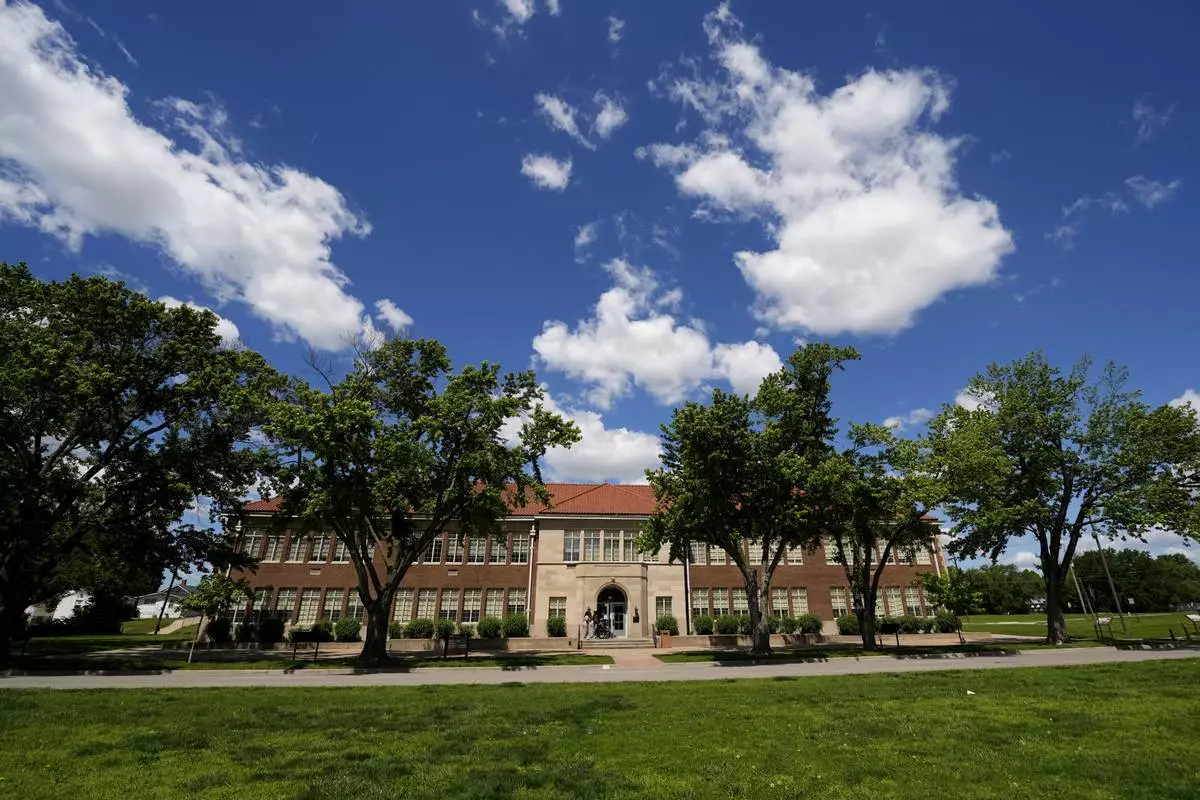
The former Monroe school, which now houses a national historic site is seen Friday, May 10, 2024, in Topeka, Kan. The school was at the center of the Brown v. Board of Education Supreme Court ruling ending segregation in public schools 70 years ago. (AP Photo/Charlie Riedel)
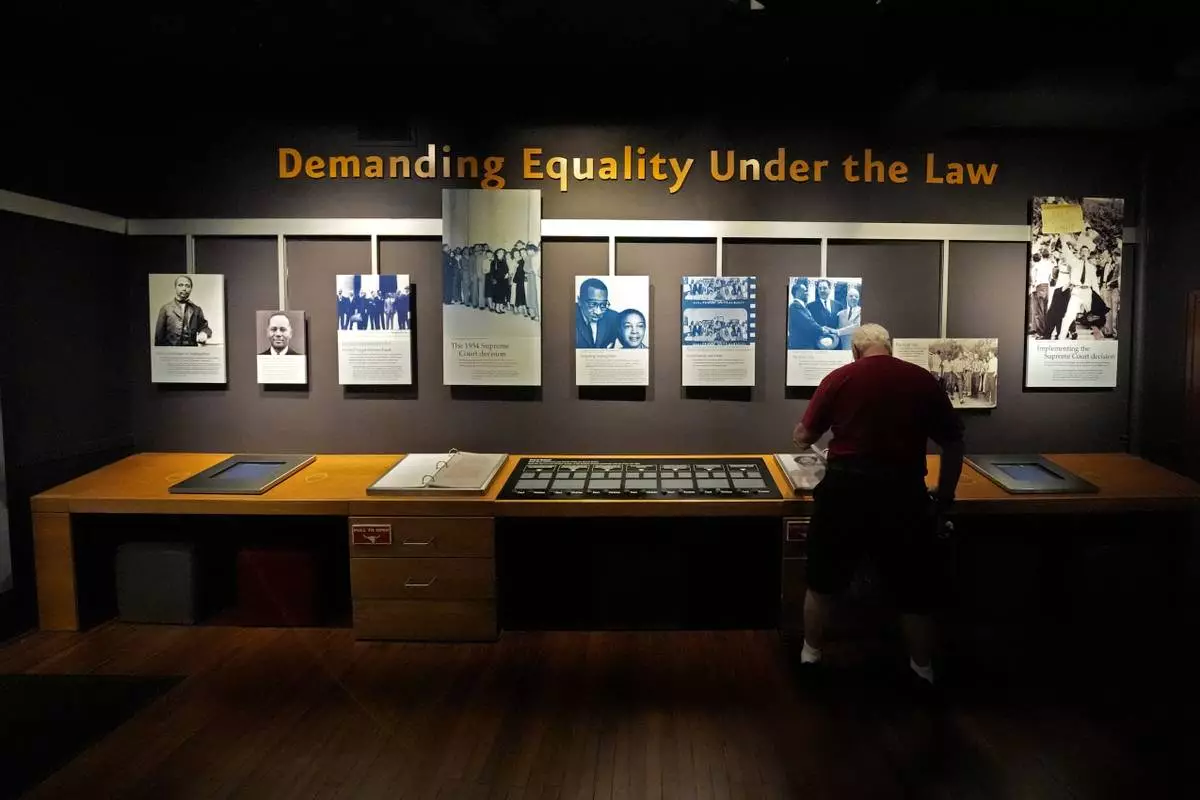
A man views an exhibit in the former Monroe school, which now houses a national historic site, Friday, May 10, 2024, in Topeka, Kan. The school was at the center of the Brown v. Board of Education Supreme Court ruling ending segregation in public schools 70 years ago. (AP Photo/Charlie Riedel)
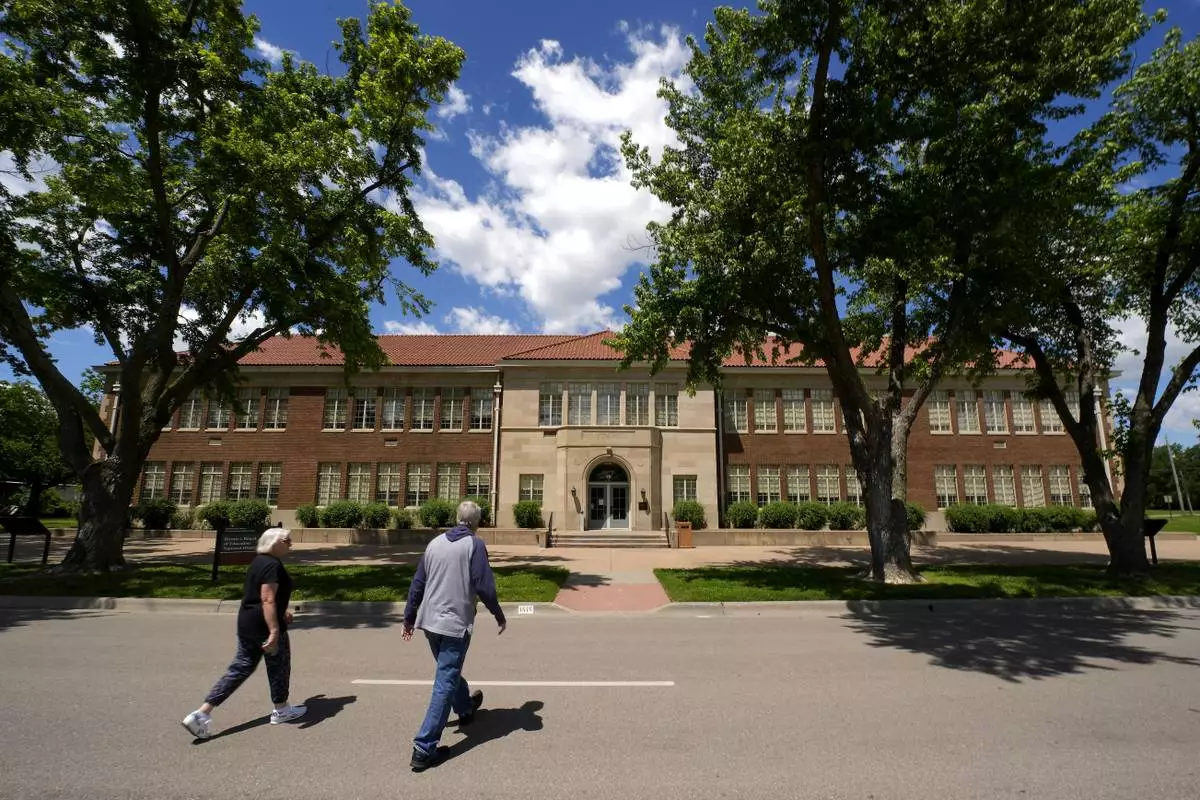
Visitors walk to the former Monroe school, which now houses a national historic site, Friday, May 10, 2024, in Topeka, Kan. The school was at the center of the Brown v. Board of Education Supreme Court ruling ending segregation in public schools 70 years ago. (AP Photo/Charlie Riedel)

Students mix in a hallway as they change classes at Topeka High school Friday, May 10, 2024, in Topeka, Kan. Topeka is the home of the former Monroe school which was at the center of the Brown v. Board of Education Supreme Court ruling ending segregation in public schools 70 years ago. (AP Photo/Charlie Riedel)

First graders Ripley Phillips, left, and Jabari Hall talk during breakfast at Williams Science and Arts Magnet school Friday, May 10, 2024, in Topeka, Kan. The school is just a block from the former Monroe school which was at the center of the Brown v. Board of Education Supreme Court ruling ending segregation in public schools 70 years ago. (AP Photo/Charlie Riedel)

First graders Ripley Phillips, left, and Jabari Hall talk during breakfast at Williams Science and Arts Magnet school Friday, May 10, 2024, in Topeka, Kan. The school is just a block from the former Monroe school which was at the center of the Brown v. Board of Education Supreme Court ruling ending segregation in public schools 70 years ago. (AP Photo/Charlie Riedel)

Fifth grader Malaya Webster, right, plays a game with other students at Williams Science and Arts Magnet school Friday, May 10, 2024, in Topeka, Kan. The school is just a block from the former Monroe school which was at the center of the Brown v. Board of Education Supreme Court ruling ending segregation in public schools 70 years ago. (AP Photo/Charlie Riedel)


